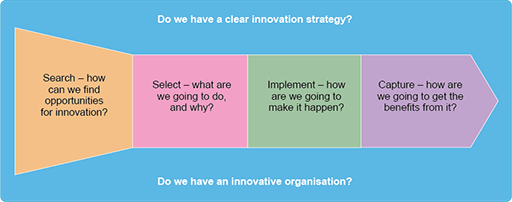8 Innovation process: how innovation happens in an organisation
The OECD/Eurostat definitions focus on what is innovated – goods, services, processes, or systems – rather than on how and why people or organisations might choose to develop or use an innovation, or how an innovation might be produced. So next we turn to consider the innovation process. The innovation process is not the same as a process innovation, but is instead the process of how innovation happens in organisations.
Innovation is a knowledge-based process, the means by which new ideas are developed and introduced. By itself, invention (or having a new idea, concept or design) is not enough – it needs to be part of a wider process that realises value. However, invention is not necessarily a part of the innovation process, although an element of novelty always is.
The innovation process may be understood with reference to the activities undertaken by individual innovators and organisations that are intended to result in innovation, including the research and development (R&D), financial and commercial activities required throughout the process. This is central to the management of technological innovation, and hence to much of this module.
While implementation is a necessary part of the innovation process, success is neither a requirement for an innovation to be counted as such, nor an essential consequence of the process (OECD/Eurostat, 2018). Clearly, success in capturing value from the innovation process is the main goal of the innovating organisation. However, innovations can fail once launched, although innovation management, innovation strategy and the innovativeness of the organisation play a big role in achieving success (Tidd and Bessant, 2018).
Figure 5 illustrates a simple model, developed by Tidd and Bessant (2018), of the innovation process as a series of phased activities, progressing from searching, selecting and implementing ideas in a context to capturing value for the innovating organisation.

To learn more about the different phases of the innovation process, the next activity involves matching the description of the Search, Select, Implement and Capture (SSIC) phases to the correct description.
Activity 3: SSIC phases
To learn more about the different phases of the innovation process, match the description of the SSIC phases to the correct description.
Using the following two lists, match each numbered item with the correct letter.
-
Looking for ideas in the internal and external environment, such as market signals of opportunities and threats.
-
Choosing an idea for innovation and making a strategic decision about what the organisation is best placed to do in response to the options identified as a result of the searching phase.
-
Transforming an idea to be ready to launch in a context in conditions characterised by uncertainty.
-
Exploiting the value from the innovation, sustaining value for the organisation and learning to improve innovation management.
a.Implement
b.Search
c.Capture
d.Select
- 1 = b
- 2 = d
- 3 = a
- 4 = c
Before moving on, take a few minutes to think through some of the activities that could be taken at each of the Search, Select, Implement and Capture phases of the innovation process. You might find it helpful to focus your thoughts on an innovation relevant to an organisation or sector that you are familiar with or have an interest in.
Comment
What makes this model attractive is its generic features, which means that it can be used to describe and examine most innovation processes associated with product, process and system innovations in different contexts. That said, the SSIC model developed by Tidd and Bessant (2018) is one of several models of the innovation process available to look at relationships between innovation and organisational processes. This model presents innovation as quite a simple process, when in reality the risks and uncertainties associated with innovation can make success difficult to achieve. For now, though, it serves our purpose in recognising that the process of innovation needs to describe what happens in situations where the aims may be to introduce different types of innovations.
